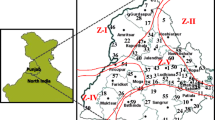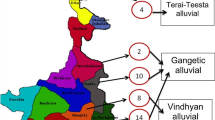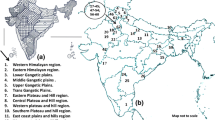Abstract
Rhizoctonia solani is a destructive soil borne plant pathogen that infects various crops including rice. A total of 35 isolates of R. solani from rice and other different hosts were collected and established. Morphological characterization was done on PDA media by analyzing radial growth, sclerotial pattern and colony colour. Pathogenicity test was conducted in a susceptible variety of rice Pusa Basmati 1. Maximum lesion height (86%) was observed for isolate TP3 and TP26 whereas, the minimum disease was observed for the isolate TP30 (29.2%). Molecular markers namely, internal transcribed spacer (ITS), universal rice primer (URP) and simple sequence repeats (SSR) were used to determine the genetic diversity of the pathogen. The phylogenetic tree obtained based on ITS region sequences grouped R. solani isolates in a single main cluster and 6 subclusters. Based on URP and SSR markers, isolates of R. solani were grouped into three and six clusters respectively. The structure analysis and AMOVA analysis revealed greater genetic variation within populations (91%) compared to among populations (9%). The results demonstrated that R. solani isolates evaluated were pathogenic to rice, irrespective of the host, however, variation exists at molecular level. The findings highlighted the diversity and complexity of the genetic background of R. solani which will be helpful to develop management strategies against the sheath blight disease of rice. Further, R. solani isolates from the host species finger millet (Eleusine coracana), lablab bean (Lablab purpureus), and ginger (Zingiber officinale) were first time characterized from the North-Eastern state through this study.






Similar content being viewed by others
Data availability
All data generated or analysed during this study are included in this published article and the raw datasets generated during and/or analysed during the current study are available from the corresponding author on reasonable request.
References
Anderson NA (1982) The genetics and pathology of Rhizoctonia solani Annu Rev Phytopathol 20:329–347
Banerjee S, Datta S, Mondal A, Bhattacharya S (2012) Characterization of molecular variability in Rhizoctonia solani isolate from different agro-ecological zone by random amplified polymorphic DNA (RAPD) markers. Afr J Biotechnol 11:9543–9548
Bhaktavatsalam G, Satyanarayana K, Reddy APK, John VT (1978) Evaluation of sheath blight resistance in rice. Int Rice Res Notes 3:9–10
Bhunkal N, Singh R, Mehta N (2015) Assessment of losses and identification of slow blighting genotypes against sheath blight of rice. J Mycol Pl Pathol 45:285–292
Chahal SS, Sokhi SS, Ratan GS (2003) Investigation on sheath blight of rice in Punjab. Indian Phytopathol 56:22–26
Cumagun CJR, McDonald BA, Arakawa M, Castroagudín VL, Sebbenn AM, Ceresini PC (2020) Population genetic structure of the sheath blight pathogen Rhizoctonia solani AG-1 IA from rice fields in China, Japan and the Philippines. Acta Sci Agron 42
Delseny M, Salses J, Cooke R, Sallaud C, Regad F, Lagoda P, Guiderdoni E, Ventelon M, Brugidou C, Ghesquière A (2001) Rice genomics: Present and future. Plant Physiol Biochem 39:323–334
DRR (2006–2010) Progress Report, 2005–2009, Vol. 2, Crop Protection, Entomology and Pathology, All India Coordinated Rice Improvement Project, ICAR, DRR, Rajendranagar, Hyderabad, Andhra Pradesh, India
Dubey SC, Tripathi A, Upadhyay BK (2012) Molecular diversity analysis of Rhizoctonia solani isolates infecting various pulse crops in different Agro-Ecological regions of India. Folia Microbiol 57:513–524
Dubey SC, Tripathi A, Upadhyay BK, Deka UK (2014) Diversity of Rhizoctonia solani associated with pulse crops in different agro-ecological regions of India. World J Microbiol Biotechnol 30:1699–1715
Earl DA, vonHoldt BM (2012) Structure Harvester: A website and program for visualizing STRUCTURE output and implementing the Evanno method. Conserv Genet Resour 4:359–361
Evanno G, Regnaut S, Goudet J (2005) Detecting the number of clusters of individuals using the software STRUCTURE: A simulation study. Mol Ecol 14:2611–2620
FSA/USDA (2011) Foreign Service Association of United States Department of Agriculture Office of Global Analysis
Ganeshamoorthi P, Dubey SC (2013) Anastomosis grouping and genetic diversity analysis of Rhizoctonia solani isolates causing wet root rot in chickpea. Afr J Biotechnol 12:6159–6169
Hobbs PR (2001) Tillage and crop establishment in South Asian rice-wheat systems: present and future options. J Crop Prod 4:1–23
Kang HW, Park DS, Park YJ, You CH, Lee BM, Eun MY, Go SJ (2002) Fingerprinting of diverse genomes using PCR with universal rice primers generated from repetitive sequence of Korean weedy rice. Mol Cells 13:281–287
Lal M, Singh V, Kandhari J, Sharma P, Kumar V, Murti S (2014) Diversity analysis of Rhizoctonia solani causing sheath blight of rice in India.Afr J Biotechnol 13
Lal ME, Kandhari JA, Singh VI (2012) Characterization of virulence pattern in Rhizoctonia solani causing sheath blight of rice. Indian Phytopathol 65:60–63
Madhavi M, Reddy PN, Reddy RR, Reddy SS (2015) Morphological and molecular variability of Rhizoctonia solani isolates causing banded leaf and sheath blight in maize. Int J Bio-Resour Stress Manag 6:375–385
Mirmajlessi S, Safaie N, Mostafavi HA, Mansouripour SM, Mahmoudy SB (2012) Genetic diversity among crown and root rot isolates of Rhizoctonia solani isolated from cucurbits using PCR-based techniques. Afr J Agric Res 7:583–590
Mishra PK, Gogoi RO, Singh PK, Borah JY, Rai SN (2015) Genotypic variability in isolates of Rhizoctonia solani from rice, maize and greengram. Indian Phytopathol 68:56–62
Murray MG, Thompson WF (1980) Rapid isolation of high molecular weight plant DNA. Nucleic Acid Res 8:4321–4325
Ogoshi A (1987) Ecology and pathogenicity of anastomosis and intraspecific groups of Rhizoctonia solani Kuhn. Annu Rev Phytopathol 25:125–143
Ou SH (1985) Rice diseases: Commonwealth Mycological Institute
Paracer CS, Chahal DS (1963) Sheath blight of rice caused by Rhizoctonia solani Kuhn – A new record in India. Curr Sci 32:328–329
Parmeter JR ed (1970) In: Rhizoctonia solani: Biology and Pathology. University of California Press, Berkeley, CA, p 32
Parmeter JR, Whitney HS (1970) Taxonomy and nomenclature of the imperfect state. In: Parmeter J R. Rhizoctonia solani: Biology and Pathology. Berkely: University of California Press, pp 7–19
Peakall R, Smouse PE (2012) GenAlEx 6.5: Genetic analysis in Excel. Population genetic software for teaching and research-an update. Bioinformatics 28:2537–2539
Pritchard JK, Stephens P, Donnelly P (2000) Inference of population structure using multilocus genotype data. Genetics 155:945–959
Prashantha ST, Bashyal BM, Gopala Krishnan S, Himanshu D, Prakash G, Rashmi A (2021) Identification and expression analysis of pathogenicity-related genes of Rhizoctonia solani anastomosis groups infecting rice. 3 Biotech 11:394
Rohlf FJ (1998) NTSYS-PC Numerical Taxonomy and Multivariate Analysis System, Setauket, NY, USA. Exeter Publishing, Setauket, New York
Sandoval Regina Faye C, Cumagun Christian Joseph R (2019) Phenotypic and molecular analyses of Rhizoctonia spp. associated with rice and other hosts. MDPI Microorganisms 7(3):88
SES (1996) (Standard Evaluation System), IRRI, Manila, Philippines 25
Sharma M, Gupta SK, Sharma TR (2005) Characterization of variability in Rhizoctonia solani by using morphological and molecular markers. Phytopathology 153:449–456
Shu CW, Zou CJ, ChenJL TF, Yi RH, Zhou EX (2014) Genetic diversity and population structure of Rhizoctonia solani AG-1 IA, the causal agent of rice sheath blight, in South China. Can J Plant Pathol 36:179–186
Singh SK, Shukla V, Singh H, Sinha AP (2004) Current status and impact of sheath blight in rice (Oryza sativa L.) a review. Agric Rev 25(4):289–297
Sunder S, Singh R, Dohan DS (2003) Standardization of inoculation method and management of sheath blight of rice. Indian J Plant Pathol 21:92–96
Susheela K, Reddy CS (2013) Variability in Rhizoctonia solani (AG-1 IA) isolates causing sheath blight of rice in India. Phtyopathol 66:341–350
Taheri P, Gnanamanickam S, Höfte M (2007) Characterization, genetic structure, and pathogenicity of Rhizoctonia spp. associated with rice sheath diseases in India. Phytopathol 97:373–383
Toda T, Hyakumachi M, Arora DK (1999) Genetic relatedness among and within different Rhizoctonia solani anastomosis group as assessed by RAPD, ERIC, and REP-PCR. Microb Res 154:247–258
Vilgayls R, Cubeta MA (1994) Molecular systematic and population biology of Rhizoctonia Annu Rev Phytopathol 32:132–155
White TJ, Bruns T, Lee S, Taylor J (1990) Amplification and direct sequencing of fungal ribosomal RNA genes for phylogenetics. In PCR protocols: a guide to methods and applications. Academic Press pp 315–322
Zheng A, Lin R, Zhang D, Qin P, Xu L, Ai P, Ding L et al (2013) The evolution and pathogenic mechanisms of the rice sheath blight pathogen. Nat Commun 4:1424
Acknowledgements
Authors are thankful to Head, Division of Plant Pathology, and IARI for providing facilities. Authors are also thankful to College of Agriculture, Tripura for supporting in survey and collection of samples. Financial support provided under DBT in the form of project grant BT/NIPGR/Flagship-Prog/2018-19 is gratefully acknowledged.
Accession numbers: The ITS sequence data has been deposited at GenBank (Accession no’s: ON383481 to ON383516).
Author information
Authors and Affiliations
Corresponding author
Ethics declarations
Conflicts of interest
The authors declare that they have no conflict of interest in the publication.
Additional information
Publisher's Note
Springer Nature remains neutral with regard to jurisdictional claims in published maps and institutional affiliations.
Supplementary Information
Below is the link to the electronic supplementary material.
Rights and permissions
Springer Nature or its licensor (e.g. a society or other partner) holds exclusive rights to this article under a publishing agreement with the author(s) or other rightsholder(s); author self-archiving of the accepted manuscript version of this article is solely governed by the terms of such publishing agreement and applicable law.
About this article
Cite this article
Singh, A., Chandra, P., Bahadur, A. et al. Assessment of morpho-cultural, genetic and pathological diversity of Rhizoctonia solani isolates obtained from different host plants. J Plant Pathol 106, 67–82 (2024). https://doi.org/10.1007/s42161-023-01515-w
Received:
Accepted:
Published:
Issue Date:
DOI: https://doi.org/10.1007/s42161-023-01515-w




